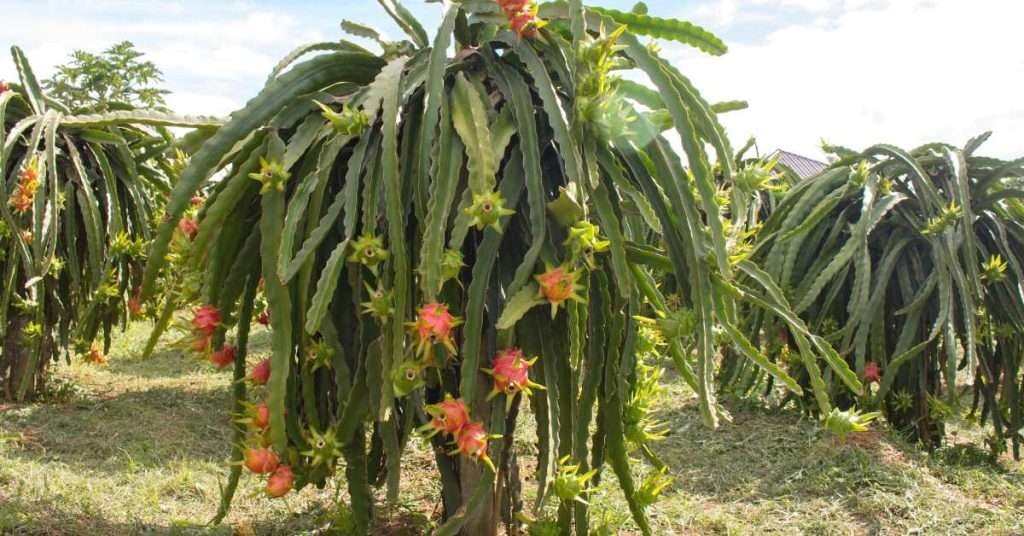Dragon fruit, also known as Pitahaya or Strawberry pear, is a tropical fruit known for its bright red skin and sweet pulp dotted with seeds. Its unique appearance and acclaimed superfood powers have made it popular among foodies and the health-conscious.
What is Dragon Fruit?

Dragon fruit grows on the Hylocereus cactus, an epiphytic evergreen, climbing, or shrub succulent with triangular stalks that can grow up to 20 feet long! In its homeland, Mexico and Central America, it grows as an impressive plant 13 to 20 feet high which climbs and adheres to the substrate with the help of aerial roots.
The plant blooms with gorgeous single aromatic bell-shaped, yellow-green flowers up to a foot long and 7 to 9 inches across. The flowers open in the evening and closes at dawn, which inspired its name Queen of the Night.
Aside from the mentioned, the plant goes by many other names, including Pitaya, Pitahaya, Strawberry pear, and Honolulu Queen.
The short life span of the flower may be disappointing, but it is comforting that the plant, under adequate conditions, has 4 to 6 flowering and fruiting cycles per year. Pollinated flowers give the large ovoid fruits 3 to 5 inches long and two to three inches wide with a sweet taste.
RELATED: What Does Dragon Fruit Taste Like?
Dragon Fruit Varieties
The most commonly grown varieties of dragon fruit are Hylocereus guatemalensis (America Beauty) and Hylocereus polyrhizus ( Red dragon) with fuchsia red pulp and reddish green peel. Hylocereus undatus also has red fruit, but the fruit flesh is white. Yellow dragon fruit (Hylocereus megalanthus) also has white pulp, but the skin is bright yellow, hence the name.
DISCLAIMER: THIS WEBSITE DOES NOT PROVIDE MEDICAL ADVICE The information, including but not limited to, text, graphics, images and other material contained on this website is for informational purposes only. No material on this site is intended to be a substitute for professional medical advice, diagnosis, or treatment. Always seek the advice of your physician or other qualified healthcare providers with any questions you may have regarding a medical condition or treatment before undertaking a new healthcare regimen, and never disregard professional medical advice or delay in seeking it because of something you have read on this website or in any linked materials.
What is a Dragon Fruit Good For?
- improves eye health
- accelerates metabolism and digestion
- increases appetite
- for more beautiful skin
- to reduce blood fat
- for regulation of blood glucose levels
- for libido stimulation
Dragon Fruit Taste
What does dragon fruit taste like? Dragon fruit has a slightly sweet and tropical taste. It is often described as having a flavor similar to a cross between a pear and a kiwi.
How to Grow Dragon Fruit

“As an Amazon Associate, I earn from qualifying purchases.”
Due to its impressive size and the great need for the sun, dragon fruit is best grown outdoors where climatic conditions allow it.
However, you can grow it as a potted plant in colder regions if you provide it with a sufficiently sunny space and a warm environment,
In addition, if you want to enjoy its juicy fruits, you will probably have to pollinate the flowers by hand!
However, do not let this put you off – despite everything, Dragon fruit is easy to grow once you provide the primary conditions it requires!
Temperature
Like other types of cacti, dragon fruit is a plant for warm and dry climates. As a garden plant outdoors, it can only grow in climate zones 10 and 11 (southern California and Florida), where the temperature ranges from 32 to 90 Fahrenheit. It can be grown in a greenhouse or indoors in colder climates, where temperatures range from 65 to 85 Fahrenheit.
Soil
To grow Pitaya in a container, you can use a ready-made mixture for cacti or make a homemade blend of equal parts of compost, sand, and garden soil.
In the garden, the plant also requires very permeable and airy soil. If the soil is compacted or heavy, you can improve it by adding pumice or sand within 3 feet of the roots.

Fertilizing
This cactus is a modest plant, so feed it carefully since an excess of nutrients can easily lead to the decay of the plant. Therefore you could use a slow-realize fertilizer for cacti with a low nitrogen content applying it once a month during the growing season.
Light
Dragon fruit is a tropical plant that requires sun and heat to bloom and form fruits. It needs at least 6 to 8 hours of direct sunlight daily.
However, the relentless bright sun next to the south window can damage its shoots. Therefore it’s best to place it next to a west or east window.
Additionally, rotate the plant occasionally to provide even lighting on all sides.
Potting
If you opt to grow Pitaya in a container, choose a large, stable, heavy one, 14 to 16 inches in diameter and at least 10 inches deep. The best option is a ceramic pot with drainage holes. Since the Pitaya is a climber, provide a trellis or vertical pole-like support with a ring at the top.
Repotting
- Grows up to 20 feet long.
- Likes full sun.
- Water when dry.
- Flowers bloom only at night.
- Ships in a 3” inch pot.
Pitaya does not like root bound, so you have to transplant it every spring into a one-inch larger container.
Mature plants need a 25-gallon container, so if you have enough space, it may be best to use such a container from the beginning to avoid frequent repotting, which may damage the delicate roots.
Pruning
Pruning is necessary to control this cactus’s size and shape. However, do not start pruning until the plant is at least a year old or until it has completed at least one flower cycle.
You can prune your Pitaya plant by removing thin lateral and excessively branched shoots.
This process contributes to shaping but also provides better air circulation and prevents the development of fungal and bacterial infections.
Watering
Roughly, you should water your plant every 15 days, but the rhythm always depends on other growth factors such as temperature and sun exposure, the size of the plant, and the container in which it grows. In winter, reduce watering because the plant enters a dormant phase.
Humidity
Dragon fruit is comfortable in standard indoor humidity between 30 and 50%. In winter, if the heating dries out of the air, you can occasionally mist it or place it on a pebble tray.
Pests and Diseases
Common pests such as aphids, mealybugs, or spider mites can settle on your plant. Remove them by rinsing or using neem oil solution.
Pay attention to proper watering and proper drainage in the container because excess water around the roots can lead to root rot or the appearance of mold.
Propagation of Dragon Fruit
You can propagate Pitaya by seeds and seedlings. However, growing from seeds is time-consuming since you can expect fruit from a plant grown in this way only in a few years. That is why cuttings inserted into a sandy substrate are a much faster and more reliable method.







